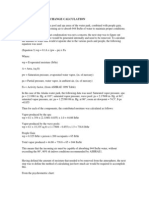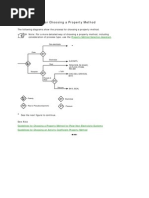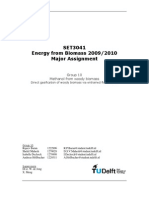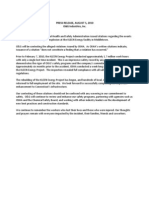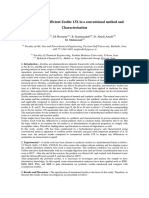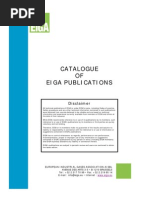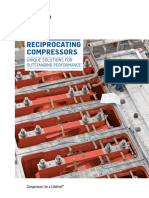0 ratings0% found this document useful (0 votes)
81 viewsRESUME Chemical Engineering Magazine
RESUME Chemical Engineering Magazine
Uploaded by
jihan safThe document summarizes several topics related to chemical engineering:
1) A startup is developing a technology to produce hydrogen from organic waste using microbial electrolysis.
2) Updates on new plant constructions including a carboxylic acid plant in Germany and a biorefinery in France.
3) Plans to build the world's largest lyocell fiber plant in Thailand.
Copyright:
© All Rights Reserved
Available Formats
Download as PPTX, PDF, TXT or read online from Scribd
RESUME Chemical Engineering Magazine
RESUME Chemical Engineering Magazine
Uploaded by
jihan saf0 ratings0% found this document useful (0 votes)
81 views12 pagesThe document summarizes several topics related to chemical engineering:
1) A startup is developing a technology to produce hydrogen from organic waste using microbial electrolysis.
2) Updates on new plant constructions including a carboxylic acid plant in Germany and a biorefinery in France.
3) Plans to build the world's largest lyocell fiber plant in Thailand.
Original Description:
Yy
Copyright
© © All Rights Reserved
Available Formats
PPTX, PDF, TXT or read online from Scribd
Share this document
Did you find this document useful?
Is this content inappropriate?
The document summarizes several topics related to chemical engineering:
1) A startup is developing a technology to produce hydrogen from organic waste using microbial electrolysis.
2) Updates on new plant constructions including a carboxylic acid plant in Germany and a biorefinery in France.
3) Plans to build the world's largest lyocell fiber plant in Thailand.
Copyright:
© All Rights Reserved
Available Formats
Download as PPTX, PDF, TXT or read online from Scribd
Download as pptx, pdf, or txt
0 ratings0% found this document useful (0 votes)
81 views12 pagesRESUME Chemical Engineering Magazine
RESUME Chemical Engineering Magazine
Uploaded by
jihan safThe document summarizes several topics related to chemical engineering:
1) A startup is developing a technology to produce hydrogen from organic waste using microbial electrolysis.
2) Updates on new plant constructions including a carboxylic acid plant in Germany and a biorefinery in France.
3) Plans to build the world's largest lyocell fiber plant in Thailand.
Copyright:
© All Rights Reserved
Available Formats
Download as PPTX, PDF, TXT or read online from Scribd
Download as pptx, pdf, or txt
You are on page 1of 12
RESUME Chemical Engineering Magazine
Agustus 2019
Wahyu Kurniawan 1714014
Rizqy fajar sodiq 1714030
Chementator
• Microbial electrolysis produces H2 from organic waste
•
• A modular, fuel-cell-like assembly featuring specially developed microbial communities is capable of
producing pure hydrogen from a wide range of organic wastes. Developed by startup company
Electro-Active Technologies (Oak Ridge, Tenn.; https://electroactive.tech), the microbial electrolysis
system is now in the prototype stage, and the company has plans for a pilot-scale demonstration in
2020.
•
• The technology offers a way to produce a carbon-free renewable fuel and industrial gas from food
waste, and other organic material that might otherwise end up in landfills, generating methane, a
potent greenhouse gas. “With microbial electrolysis, we are able to produce pure hydrogen at half the
cost of conventional water electrolysis, while also utilizing food waste as a resource,” says company
CEO Alex Lewis, who co-founded the company with his former advisor Abhijeet Borole after
completing his doctoral research project in this area at Oak Ridge National Laboratory (www.ornl.gov).
Plant Watch
• Oxea to build new carboxylic acids plant in Germany
•
• July 6, 2019 —Oxea (Monheim am Rhein, Germany; www.oxea-chemicals.com) is building a new world-scale production plant for
carboxylic acids in Oberhausen, Germany. When brought onstream by the end of 2021, it will double the current production capacity for
isononanoic acid and increase Oxea’s total production capacity for carboxylic acids by more than 30%.
•
• Total starts up biorefinery in southeast France
•
• July 3, 2019 — Total (Paris, France; www.total.com) has started up production at the La Mède biorefinery in southeastern France, with the
first batches of biofuel coming off the line. It is the final step in converting a former oil refinery into a new energies complex. Launched in
2015, the project represents a capital expenditure of €275 million. The biorefinery has a capacity of 500,000 metric tons per year (m.t./yr).
•
• Lenzing Group builds world’s largest lyocell fiber plant in Thailand
•
• June 26, 2019 — Over the next few years, Lenzing Group (Lenzing, Austria; www.lenzing.com) plans to invest more than €1 billion in new
production facilities for lyocell fibers. The first expansion phase of this growth plan, the construction of a lyocell fiber production plant in
Prachinburi, Thailand, has now been approved. The plant will have a capacity of 100,000 ton/yr and feature investments of approximately
€400 million.
Increasing the Reliability of Valves Through
Design
• The latest valves are designed to last in challenging chemical
applications, increasing uptime and safety
•
• As operational efficiency and safety continue to be top priorities in the
chemical process industries (CPI), processors are demanding increased
reliability from their equipment, and valves — whether large process
control valves or small pilot, pressure reducing or specialty valves — are
no exception to this rule. Fortunately more robust valve designs, as well
as smarter valves and accessories, are boosting the performance of all
types of valves, even in the harshest of environments.
Focus on Pipes, Tubing and Fittings
• The CorroLogic CorrPlug caps (photo) protect pipe ends, pipe threads and
other tubular objects from corrosion, mechanical damage and intrusion (by
foreign objects) during storage and shipping. These pipe caps are
constructed from heavy-wall black polyethylene that contains proprietary,
vapor-phase corrosion inhibitors. They are designed for easy installation and
removal, which helps to reduce labor needs. During humidity testing, pipe
threads equipped with these caps showed a significant advantage in
corrosion resistance compared to those capped with regular plastic caps
that contain no corrosion inhibitors, says the company. These caps are made
to order in most standard NPT pipe sizes, ranging from 0.25 to 65 in. in dia.
They protect carbon steel, stainless steel, copper, brass and aluminum pipes.
— Cortec Corp., St. Paul, Minn.
Selecting a Heat-Transfer Fluid Supplier
• Lean workforces are the norm in current plant environments. In the context of heat exchange systems,
the current situation amplifies the need to select a heat-transfer fluid supplier with the expertise and
technical resources to handle non-routine circumstances. This one-page reference outlines questions
that operating companies should consider when selecting a supplier.
•
• Product options
•
• Products backed by years of history and consistency of published data carry less technical risk. Early in
project cycles, fluid selection often requires close collaboration with fluid experts to select the optimal
chemistry to meet heat-duty demands, provide longevity with low lifecycle costs, and limit risks for
operational and process safety. Allowing a heat-transfer system to be a testing ground for inexperienced
vendors or products that are unproven in the given application presents significant risks. Suppliers with
broad experience with established fluids in varying applications mitigate that risk. Consider the value of
using a supplier with a large portfolio, proven technical data and properties, and a variety of chemistries
from which to choose.
Titanium Dioxide Production
• This column is based on “Titanium Dioxide Production Process – Cost Analysis,” a report
published by Intratec. It can be found at: www.intratec.us/analysis/titanium-dioxide-production-
cost.
•
• Titanium dioxide (TiO2) is the naturally occurring oxide of titanium, and is found particularly in
rutile ores. The compound has great technological importance: it is a commodity chemical
widely used in paints, coatings, plastics, food, cosmetics and pharmaceuticals. The vast majority
of titanium ore is processed into titanium dioxide, the most used titanium product.
•
• The process
•
• The process under analysis comprises three major sections: (1) ilmenite processing; (2) titanium
dioxide hydration; and (3) titanium dioxide treatment
Liquid Mixing in Stirred Tanks
• A method of quantifying mixing according to a mixing index is presented. This index
can evaluate and predict mixing intensity related to fluid velocities in stirred tanks
•
• The stirred tank is one of the most common and versatile pieces of chemical
process equipment. While every chemical engineer has had a course about
chemical reactors and has encountered the concept of a continuous stirred tank
reactor (CSTR), very few of those same engineers can evaluate or predict the mixing
performance of a stirred tank. While some stirred tanks are used as continuous
flow reactors, others are used as batch reactors. Many more stirred tanks are used
for physical processing of formulations without any chemical reactions. A method
of quantifying mixing according to a mixing index can evaluate and predict mixing
intensity related to fluid velocities in stirred tanks.
Beyond Simple Mixing
• Five different examples are presented in which specialty mixers are used to
perform tasks more efficiently than conventional approaches
•
• Specialty mixers serve a vast range of applications throughout the chemical
process industries (CPI). The approach to mixer selection invariably starts with
examining the different phases to be combined (solid/liquid, liquid/liquid, semi-
solid/liquid, gas/liquid and so on). Considering the miscibility of the various raw
materials, it’s easy to see how the underlying objective — uniformity — is easier
to achieve in some mixing operations more than others. Apart from miscibility,
various other application factors impose challenges to mixing. These include
non-Newtonian behavior, agglomeration, sensitivity to shear, temperature-
related degradation and competing chemical reactions, just to name a few.
Considerations for Industrial Gas Purification
• Purity requirements and gas properties require different methods for the purification of industrial
gases. Provided here are key considerations for selecting gas purification technology
• Industrial gases are critical for a wide range of applications throughout the chemical process
industries (CPI). In most cases, industrial gases are produced to a particular purity specification,
which means they may contain only a limited quantity of contaminants. For many applications, the
gases provided by suppliers may not meet process specifications for a given process, meaning that
the gas would require purification to further reduce contaminants. An improved understanding of
industrial gas generation, storage and separation can help with the selection of the gas purification
technology that meets process needs. A number of key considerations can have an impact on the
type of gas purifier selected. These include the following: the production method for the gas
supply; the purity of the gas source; how the gas source is packaged; the species of impurity
molecules to be removed and the expected purity; as well as media selection, media capacity,
space velocity, package design and shipping requirements. This article discusses the production of
industrial gases with respect to methods of purification, storage, safety and shipping.
Tailgas Considerations for Biogas Upgrading
• Thermal oxidation is used to destroy tailgas from biogas-upgrading facilities.
Presented here are guidelines for selecting the proper method
•
• With the evolving economics of renewable energy credits comes increased
interest in biogas-upgrading facilities. Renewable natural gas (RNG) plants are
being designed and built at a remarkable pace. Many scholarly articles have been
written to address the pros and cons of each popular method of biogas
enhancement. The objective is to process as much of the methane into a high-
purity form for injection into the natural gas pipeline, while efficiently removing
all undesirable impurities from the raw gas. These impurities include O2, H2O,
H2S, N2, CO2 and other trace amounts of volatile organic compounds (VOCs)
that are present in the feed.
Controlling Dust through Pelletizing
• Tumble-growth agglomeration can reduce dust in solids-handling processes. Here’s how
it works
• Handling and processing bulk solids appears in nearly every industrial sector, from
energy to agriculture. Dust is a ubiquitous and challenging issue when working with bulk
solids, because it can create hazardous or unsanitary work environments, transportation
problems and financial waste in the form of lost product.
•
• It is not surprising then, that each year, companies go to great expense to control and
mitigate dust. One of the most effective ways to manage dust is through pelletizing — a
form of tumble-growth agglomeration (particle size enlargement) that produces rounded
or spherical granules. Pelletizing can be an invaluable tool in managing dusty bulk solids
that opens opportunities in beneficial reuse applications, creates marketable products
and mitigates the handling and processing challenges associated with dust.
You might also like
- Flammability of Mixtures of Co2 and HydrocarbonsDocument17 pagesFlammability of Mixtures of Co2 and HydrocarbonsLakshmi Binoy MenonNo ratings yet
- Enthaphy of Fusion CRC Handbook of Chemistry and PhysicsDocument7 pagesEnthaphy of Fusion CRC Handbook of Chemistry and Physicsdailycrane1No ratings yet
- Time of Perplexity PDFDocument19 pagesTime of Perplexity PDFdeodrrsNo ratings yet
- 2013 GDS CatalogDocument72 pages2013 GDS CatalogAl Dizdar NazarNo ratings yet
- FulltextDocument95 pagesFulltextGuilherme MoreiraNo ratings yet
- Review Bipolar Plate PEMFCDocument17 pagesReview Bipolar Plate PEMFCDeni ShidqiNo ratings yet
- Lecture 4 - Loop and PathDocument44 pagesLecture 4 - Loop and Path翁宝怡No ratings yet
- Lecture 3a Unit OperationsDocument17 pagesLecture 3a Unit OperationsAnilKumarNo ratings yet
- A Church Without Spot, Wrinkle or BlemishDocument13 pagesA Church Without Spot, Wrinkle or BlemishSteve-O0% (1)
- N-Propanol - CAS # 71-23-8: Product Handling GuideDocument2 pagesN-Propanol - CAS # 71-23-8: Product Handling Guidesharmi2011No ratings yet
- NRTL ModelDocument4 pagesNRTL ModelJoseph GohNo ratings yet
- Modelling of Fischer Tropsch ReactorDocument8 pagesModelling of Fischer Tropsch Reactorvenky1134No ratings yet
- Kurevija GTLDocument8 pagesKurevija GTLRamakrisnanMeenakshiSundaramRamaNo ratings yet
- Syngas ProductionDocument10 pagesSyngas ProductionOliver Everett EspinoNo ratings yet
- Liden 1988Document16 pagesLiden 1988Sajid Mohy Ul DinNo ratings yet
- DrivingForceAnalysis Good PhDThesis FTreactor Code MatlabDocument267 pagesDrivingForceAnalysis Good PhDThesis FTreactor Code MatlabMinhaj GhouriNo ratings yet
- Hitec Solar SaltDocument3 pagesHitec Solar Saltlmf_pachecoNo ratings yet
- Mechanism of Hydrogen Formation in Solar Parabolic Trough ReceiversDocument8 pagesMechanism of Hydrogen Formation in Solar Parabolic Trough Receiversjemakl1568No ratings yet
- The Holy Bible - New King James Version - NKJVDocument1,663 pagesThe Holy Bible - New King James Version - NKJVosiris2112No ratings yet
- Lecture 1 Intro Energy TargetsDocument56 pagesLecture 1 Intro Energy Targets翁宝怡No ratings yet
- Main Routes For The Thermo-Conversion of Biomass Into Fuels and Chemicals.Document11 pagesMain Routes For The Thermo-Conversion of Biomass Into Fuels and Chemicals.Julio Cesar Jimenez BautistaNo ratings yet
- A Review On The Catalytic Pyrolysis of Biomass For The Bio-Oil Production WithDocument15 pagesA Review On The Catalytic Pyrolysis of Biomass For The Bio-Oil Production WithDaniiela Melo RomeroNo ratings yet
- Life Cycle Assessment of Electricity Generation in Mauritius - SIMAPRO PDFDocument11 pagesLife Cycle Assessment of Electricity Generation in Mauritius - SIMAPRO PDFLeonardo Caldas100% (1)
- Project On Bio-ButanolDocument75 pagesProject On Bio-ButanolSamir ShahNo ratings yet
- Preparation and Rate of Hydrolysis of Boric Acid EstersDocument8 pagesPreparation and Rate of Hydrolysis of Boric Acid Estersfabian cotacioNo ratings yet
- Trimethylolpropane Msds enDocument12 pagesTrimethylolpropane Msds enronnyprbNo ratings yet
- Sciencedirect: Activated Carbon of Oil Palm Empty Fruit Bunch (Efb) Core and ShaggyDocument7 pagesSciencedirect: Activated Carbon of Oil Palm Empty Fruit Bunch (Efb) Core and ShaggyNierza AlfiannurNo ratings yet
- Dimethyl Ether SDS E4589Document7 pagesDimethyl Ether SDS E4589Daniil GhilescuNo ratings yet
- Aspen HYSYS Simulation of Biomass Pyrolysis For The Production of MethanolDocument5 pagesAspen HYSYS Simulation of Biomass Pyrolysis For The Production of MethanolCsk SasiNo ratings yet
- Swimming Pool Air Change CalculationDocument3 pagesSwimming Pool Air Change Calculationanas_pmNo ratings yet
- Catalytic Conversion of Plastic Waste To Fuel: ISSN: 2394-1766Document7 pagesCatalytic Conversion of Plastic Waste To Fuel: ISSN: 2394-1766Nirajkumar NairNo ratings yet
- Plastic Waste To SyngasDocument10 pagesPlastic Waste To Syngaswaseemkhan49No ratings yet
- 30+ L-Shaped Kitchen Designs - Ideas For Your KitchenDocument52 pages30+ L-Shaped Kitchen Designs - Ideas For Your KitchenRoland CepedaNo ratings yet
- Multiphase Homogeneous Catalysis PDFDocument892 pagesMultiphase Homogeneous Catalysis PDFSyukri Abd RahmanNo ratings yet
- Faculty of Chemical Engineering and Natural ResourcesDocument29 pagesFaculty of Chemical Engineering and Natural ResourcesFarid IskandarNo ratings yet
- Guideline For Choosing A Property MethodDocument12 pagesGuideline For Choosing A Property Methodjesus_manrique2753100% (1)
- Castor OilDocument6 pagesCastor OilÖzlem YılmazNo ratings yet
- Final Safety ProjectDocument15 pagesFinal Safety ProjectSaniha Aysha Ajith100% (1)
- Plastic Waste To Syngas - 1Document30 pagesPlastic Waste To Syngas - 1waseemkhan49No ratings yet
- Study On The Thermal Pyrolysis of Medical Waste (Plastic Syringe) For The Production of Useful Liquid Fuels PDFDocument53 pagesStudy On The Thermal Pyrolysis of Medical Waste (Plastic Syringe) For The Production of Useful Liquid Fuels PDFraihonaNo ratings yet
- Waste Management Project-RajkumarDocument60 pagesWaste Management Project-RajkumarRajkumar100% (1)
- Feasibility Study of Epichlorohydrin ProductionDocument4 pagesFeasibility Study of Epichlorohydrin ProductionIntratec Solutions100% (1)
- Paper - Arco Channelview Texas Explotion 1990Document12 pagesPaper - Arco Channelview Texas Explotion 1990Ruby0% (1)
- Plastic PyrolysisDocument32 pagesPlastic Pyrolysisgoogle userNo ratings yet
- SET3041 Group10 FinalDocument28 pagesSET3041 Group10 FinalRajeev BaranNo ratings yet
- Thin Film Deposition by Spray Pyrolysis and The Application PDFDocument167 pagesThin Film Deposition by Spray Pyrolysis and The Application PDFFlorin AgaiNo ratings yet
- The Reaction Between Formaldehyde and AmmoniaDocument6 pagesThe Reaction Between Formaldehyde and AmmoniaalchemistraNo ratings yet
- Hydrogen Family PDFDocument27 pagesHydrogen Family PDFDelos NourseiNo ratings yet
- OandG StatementDocument1 pageOandG Statementjfenster7540No ratings yet
- Hidrogenation of NitrobenzeneDocument6 pagesHidrogenation of NitrobenzenejinmgNo ratings yet
- Simulation and Optimization of Rice Husk Asification Using Intrinsic Reaction Rate Based CFD ModelDocument10 pagesSimulation and Optimization of Rice Husk Asification Using Intrinsic Reaction Rate Based CFD ModelKee BekiNo ratings yet
- Methanol ProductionDocument6 pagesMethanol ProductionGovind KumarNo ratings yet
- Synthesis of An Efficient Zeolite 13X in A Conventional Method and Characterization PDFDocument4 pagesSynthesis of An Efficient Zeolite 13X in A Conventional Method and Characterization PDFMourad Makhlouf100% (1)
- Aspen Simulation of Biodiesel Production Plant: March 2015Document52 pagesAspen Simulation of Biodiesel Production Plant: March 2015Diego RodriguezNo ratings yet
- A Review On Ethanol Steam Reforming For Hydrogen Pro - 2022 - International JourDocument37 pagesA Review On Ethanol Steam Reforming For Hydrogen Pro - 2022 - International JourSaepulloh Rahmat SolehudinNo ratings yet
- Energy Optimization in Fischer-Tropsch Process: Department of Chemical Engineering, Government Engineering CollegeDocument32 pagesEnergy Optimization in Fischer-Tropsch Process: Department of Chemical Engineering, Government Engineering CollegeAdithyaNo ratings yet
- 201805graphene PDFDocument204 pages201805graphene PDFMohammad RezkyNo ratings yet
- An Industrial Design Control Study For VAC Monomer Process PDFDocument11 pagesAn Industrial Design Control Study For VAC Monomer Process PDFPY YouNo ratings yet
- Mass and Energy Balances in Materials Engineering by Mark A. Schlesinger PDFDocument9 pagesMass and Energy Balances in Materials Engineering by Mark A. Schlesinger PDFsgNo ratings yet
- In-situ Characterization of Heterogeneous CatalystsFrom EverandIn-situ Characterization of Heterogeneous CatalystsJosé A. RodriguezNo ratings yet
- Temperature-Responsive Polymers: Chemistry, Properties, and ApplicationsFrom EverandTemperature-Responsive Polymers: Chemistry, Properties, and ApplicationsNo ratings yet
- Storage Tank Steel Cylinder CatalogDocument10 pagesStorage Tank Steel Cylinder CatalogGore JiangNo ratings yet
- Plant Air BrochureDocument20 pagesPlant Air Brochure陳0鴻No ratings yet
- Pryce Corp. SEC-17A - June 30, 2020Document198 pagesPryce Corp. SEC-17A - June 30, 2020nuggsNo ratings yet
- AIGA 014 - 05 Safety Audit Guidelines PDFDocument178 pagesAIGA 014 - 05 Safety Audit Guidelines PDFWaleed Ahmed MirzaNo ratings yet
- E Journal October 2011 Part 1Document646 pagesE Journal October 2011 Part 1Kays MguniNo ratings yet
- SLV Air Producuts - Project Report - KIADBDocument16 pagesSLV Air Producuts - Project Report - KIADBpk84427No ratings yet
- Catalogue EIGA PublicationsDocument21 pagesCatalogue EIGA Publicationsfrapa070No ratings yet
- Mche - LNG PlantDocument6 pagesMche - LNG Plantchris100% (1)
- ISO and EIGA Standards For Cryogenic Vessels and AccessoriesDocument36 pagesISO and EIGA Standards For Cryogenic Vessels and AccessoriesBaher Elsheikh100% (1)
- Compressor Installation and Operation Manual Rev. 1Document50 pagesCompressor Installation and Operation Manual Rev. 1noureddine BenachiNo ratings yet
- 1992 - NHSE - Engineering Symbols and Drawing Conventions - Catalogue For Use in Health Care PremisesDocument58 pages1992 - NHSE - Engineering Symbols and Drawing Conventions - Catalogue For Use in Health Care Premisesnaser712No ratings yet
- Enhanced Oil Recovery.: Nitrogen Generation and Nitrogen RejectionDocument8 pagesEnhanced Oil Recovery.: Nitrogen Generation and Nitrogen RejectionEuniceNo ratings yet
- Pneumatech Gas Generator Catalogue - LRDocument24 pagesPneumatech Gas Generator Catalogue - LRgvargas0485No ratings yet
- Product Guide 2021 EN LRDocument30 pagesProduct Guide 2021 EN LRCARLOS CHAVEZNo ratings yet
- Atlas Copco Centrifugal Compressors - InteractiveDocument27 pagesAtlas Copco Centrifugal Compressors - InteractiveYusuf Luqman HakimNo ratings yet
- PP045Document2 pagesPP045Roberto Marcio AguiarNo ratings yet
- AIGA 067 - 10 Safe Location of Oxygen and Inert Gas Vents - Reformated Jan 12 PDFDocument48 pagesAIGA 067 - 10 Safe Location of Oxygen and Inert Gas Vents - Reformated Jan 12 PDFdaimon_pNo ratings yet
- Nitrogen at Oxygen Supply and Distrubution SystemsDocument44 pagesNitrogen at Oxygen Supply and Distrubution Systemsjk.jackycheokNo ratings yet
- CDP Climate Change ResponseDocument91 pagesCDP Climate Change ResponsevisutsiNo ratings yet
- IS 2379 - Pipeline Colour CodeDocument14 pagesIS 2379 - Pipeline Colour CodeNoel Federer SarkarNo ratings yet
- The Work Immersion Program Aims The Learners ToDocument17 pagesThe Work Immersion Program Aims The Learners ToMarkis EqulNo ratings yet
- Instant download Cryogenics A Textbook 1st Edition S.S. Thipse pdf all chapterDocument75 pagesInstant download Cryogenics A Textbook 1st Edition S.S. Thipse pdf all chapterouangakissii100% (5)
- Truckfilling UnitDocument2 pagesTruckfilling Unitrieza_fNo ratings yet
- Catalog 2023 - Aerogas Industrial Supply SDN BHDDocument20 pagesCatalog 2023 - Aerogas Industrial Supply SDN BHDapi-677550906No ratings yet
- Reciprocating Compressors: Unique Solutions For Outstanding PerformanceDocument12 pagesReciprocating Compressors: Unique Solutions For Outstanding PerformancePradeeoNo ratings yet
- Hazardous Industries Notifiable and Compensable DiseasesDocument19 pagesHazardous Industries Notifiable and Compensable Diseasesviren thakkarNo ratings yet
- CO2 PURIFIER Data SheetDocument8 pagesCO2 PURIFIER Data SheetZainul AbideenNo ratings yet
- Inox Air Products To Invest Rs 645 CR To Set Up 6 Production Units in IndiaDocument2 pagesInox Air Products To Invest Rs 645 CR To Set Up 6 Production Units in IndiaKULDEEP_1997No ratings yet
- Cryogas Equipment Private LimitedDocument23 pagesCryogas Equipment Private LimitedPradeep KaushikNo ratings yet





























